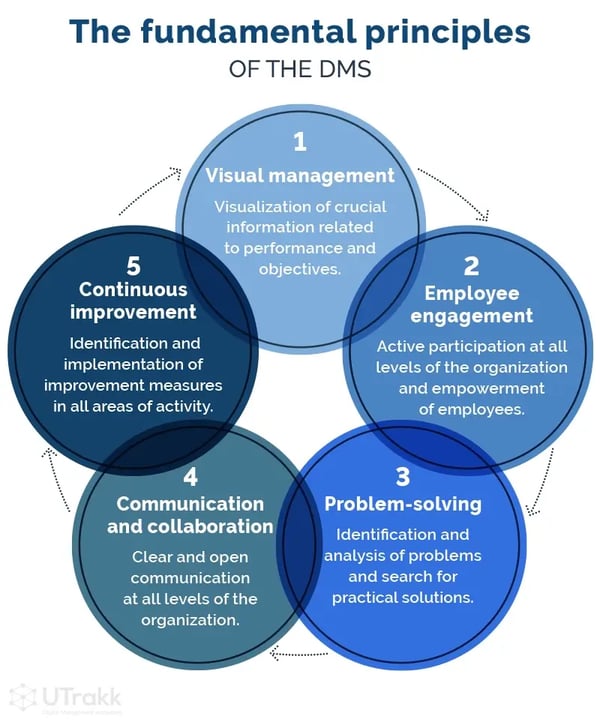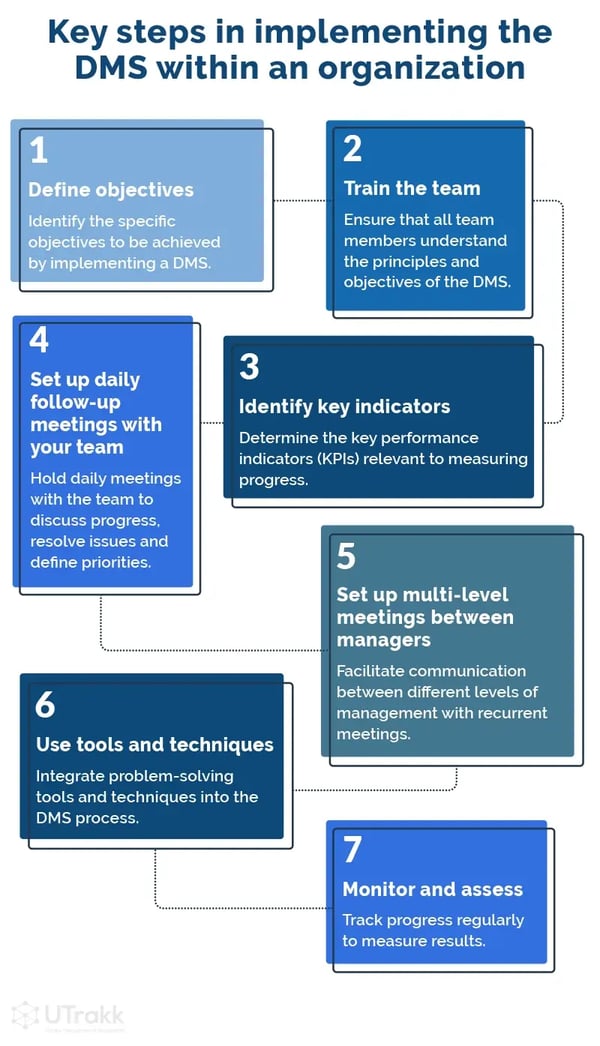What is a Lean Daily Management System?
A Daily Management System, or DMS, is software designed to improve an organization's operational efficiency and performance, by structuring managers' daily, weekly, and monthly activities.
This concept has evolved over time, influenced by various management practices such as Japanese methodologies like Kaizen and Lean Manufacturing, which contributed to forging this system.
Once based on paper and Excel spreadsheets, Daily Management Systems are now more sophisticated, with digital tools centralizing all features to enhance both managers' and companies' efficiency.
A Lean Daily Management System is based on practices such as work standardization, visual management, solving problems, and continuous improvement methods. It also enables real-time operational performance monitoring, better decision-making with tangible data, and increased employee engagement. It fosters communication, collaboration, transparency, and accountability at all organization levels.

The essential components of a DMS
A Daily Management System uses several Lean tools and techniques to facilitate daily management and continuous improvement:
-
Standardized work: Leader Standard Work refers to a set of structured essential routines and practices that managers perform in a recurring and consistent way. The DMS platform guides managers through these standardized activities, promoting effective leadership and a consistent approach to managing people and processes.
-
Daily meetings: Daily meetings (or "huddles") such as short interval management, kick-offs, and end-of-shift meetings are short, tailored meetings held at a specific time every day. They enable team members to discuss progress, solve problems, and define daily priorities.
-
Floor tours: Gemba Walk is a Lean technique that involves walking the shop floor to talk with frontline workers, identify potential problems, and make more informed decisions.
-
Problem-solving: A Daily Management System can support multiple problem-solving methods, including DMAIC (Define, Measure, Analyze, Improve, Control). This methodology is used to solve complex problems and improve manufacturing processes, through these 5 key steps: defining the problem, measuring current performance, analyzing root causes, streamlining processes, and controlling to maintain improvements.
-
Visual management: This Lean management method relies on visual tools – Kanban or DMS boards, graphics, signs, displays, etc. – to communicate important and often complex information. These aids help visualize workflows, performance, and problems in real time.
-
Key performance indicators: Dashboards and other visual tools display key performance indicators (KPIs). They offer a real-time visibility of performance, while providing relevant data to support decision-making.
-
Process optimization: A modern DMS supports the 5S methodology, a Lean technique that helps efficiently organize the workspace and maintain a clean, orderly environment. The 5S method is based on the following steps: Seiri (Sort), Seiton (Set in order), Seiso (Shine), Seiketsu (Standardize) and Shitsuke (Sustain).
-
Continuous improvement: The PDCA method is a continuous improvement methodology comprising 4 steps: Plan, Do, Check, and Act. Supported by DMS platforms, this improvement process helps identify, test, and implement effective solutions in a continuous cycle.
-
Employee engagement: A Lean Daily Management System includes features that promote team engagement by involving team members in problem-solving and achieving operational objectives.
The benefits of a Daily Management System
A Lean Daily Management System (DMS) offers many undeniable benefits, enabling companies to boost productivity and overall performance.
Improved productivity and quality
A Daily Management System creates a culture of performance that leads to operational excellence. From Gemba Walks to regular follow-up meetings, these multiple touchpoints facilitate conversations on objectives, progress made, and problems that may impact productivity and quality.
A DMS also emphasizes continuous improvement, encouraging teams to identify process improvement opportunities, eliminate waste and bottlenecks, and optimize workflows. This fosters optimal use of resources, waste reduction, improved quality management, and increased operational productivity.
Reduced costs and lead times
By eliminating non-essential activities, analyzing performance indicators, optimizing workflows, detecting problems, and quickly solving them, a DMS helps reduce costs and lead times of production operations.
Greater flexibility and adaptation to change
A DMS enables teams to be better prepared for changes and adapt more easily. With daily meetings, frontline managers can quickly share information on upcoming transformations, discuss new measures, and implement actions to encourage adoption.
Improved communication and collaboration
A Lean Daily Management System helps establish an effective, seamless communication structure within the work environment. During daily meetings, teams can share information, discuss issues and priorities, and coordinate their efforts. This avoids misunderstandings and miscommunications, and strengthens collaboration between departments.
By encouraging transparency, a DMS also fosters open and honest communication between employees.
Increased employee engagement
A DMS promotes employee involvement and engagement at all hierarchical levels of the organization. When team members are involved in problem-solving and decision-making, they are more likely to feel accountable for their actions.
As a result, the DMS strengthens workers' sense of belonging and accountability, leading to improved motivation, job satisfaction, and talent retention.
How to implement a Lean Daily Management System
Here are the key steps for the successful implementation process of a DMS within your organization:

1. Define objectives
Identify the objectives you wish to achieve by implementing a DMS (e.g., increased productivity, reduced costs, improved quality, etc.). Make sure they are aligned with the organization's vision and strategy.
2. Train your teams
Adopting a new technology can represent a major change for your team members. As a manager, you need to provide them with the best possible support. Make sure they understand the objectives of implementing a DMS. Training sessions can help explain key components, tools, and techniques.
Pro tip: Involve employees from the outset to lock their support and commitment. Frontline workers, team leaders, and companies alike benefit from a digital transformation.
3. Identify key performance indicators
Determine relevant KPIs for your SQCDP performance axes – Security, Quality, Cost, Delivery, and People – and measure progress. These KPIs must be SMART and aligned with the organization's strategic goals. Set meaningful key indicators that offer a clear view of performance.
4. Set up daily follow-up meetings
Hold short daily meetings (usually no more than 15 minutes) with appropriate teams to discuss progress, resolve problems, and define priorities.
During these meetings, use operational dashboards to display KPIs, review performance metrics, and track progress.
5. Set up tiered meetings
Organize tiered meetings to facilitate communication and problem escalation. For example, team leaders can meet to discuss information from production meetings, review identified problems, and ensure operational activities are aligned with strategic objectives.
6. Implement problem-solving methods
Integrate problem-solving tools and techniques with digitalized DMS processes. These will help you analyze problems and their root cause, and implement efficient corrective actions.
7. Monitor and assess progress
Monitoring key performance indicators on a daily basis is crucial to assessing progress and making adjustments. At the same time, carry out regular evaluations to detect and anticipate potential problems that could set you off track. Identify successes and areas for improvement, then adjust processes and practices to achieve optimal performance and operational excellence.
A DMS is not a one-size-fits-all system, but rather a management approach that can be tailored to your company's specific needs.
UTrakk DMS: The 5.0 digital solution
UTrakk is a complete Daily Management System (DMS) that guides team leaders and managers through their management activities, with powerful features that simplify operational and managerial performance management.
These functionalities focus on people by encouraging the right managerial behavior in daily operations management, turning this system into an Industry 5.0 ally.
Digitalizing management with UTrakk helps:
-
Structure and increase shop floor and active supervision tours.
-
Define and monitor action plans to solve problems and make improvements.
-
Enhance alignment and communication through collaborative tools.
-
Facilitate prioritization and decision-making with tangible data.
-
Empower and engage teams.
-
Support managers in adopting the right management behaviors.
-
Standardize and perpetuate best managerial and operational practices.
Maximize your performance with a DMS
A Lean Daily Management System like UTrakk provides a structured framework that enhances productivity, promotes a continuous improvement culture, and strengthens communication and collaboration within the entire organization. By equipping leaders with features like daily meetings, floor tour, dashboards, project tracking, and much more, this application contributes to more effective management and better overall organizational performance – day after day.
Nowadays, speed, responsiveness, and flexibility are key success factors. A Daily Management System stands as a major asset for navigating Industry 5.0. By implementing this tool, companies are in a great position to meet today's and tomorrow's challenges, and take advantage of the opportunities offered by this new industrial era.










